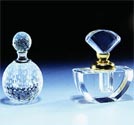The art of perfume-making in the world's "perfume capital"
Grasse, France -  Choosing the right perfume is not easy and neither is creating a good fragrance.
Choosing the right perfume is not easy and neither is creating a good fragrance.
Corinne Marie-Tosello is a graduate of the perfumery school in Grasse, the world's "perfume capital," on France's Cote d'Azur. She initiates visitors in the art of perfume-making at Grasse's renowned Fragonard Perfumery. Creating a fragrance is similar to cooking, Marie-Tosello says: You mix various ingredients and produce something wholly new.
How many different aromatic substances does a good perfume contain?
Marie-Tosello: It could be between 50 and 150. The combination is much more important than the individual scents, however. Reduced fragrances consisting of only 25 to 30 ingredients are the trend at the moment. The perfumer starts with a large number of aromatic substances and reduces it step by step, always very carefully because you don't know if you're losing something essential.
How is a new fragrance created?
Marie-Tosello: The client has an idea. There's a description of it, a kind of briefing, which goes to the perfumers, who develop a perfume. This can take a month or several. Then the perfumers send samples to the client, who decides on a fragrance. There's a lot of competition among the perfumers.
How do consumers determine which perfume suits them?
Marie-Tosello: You know whether or not you like a perfume in the first seconds that you smell it. Some perfumes contain something that's subconsciously appealing. If you sample a lot of different perfumes, you'll find you're always drawn to similar ones, from the same perfume family, such as fruity, spicy or vanilla-based. All that's left to do is sample within this group until you've got one that you like.
First you should test perfume on a smelling strip, and then on the skin, because perfume smells different on different people's skin. (dpa)